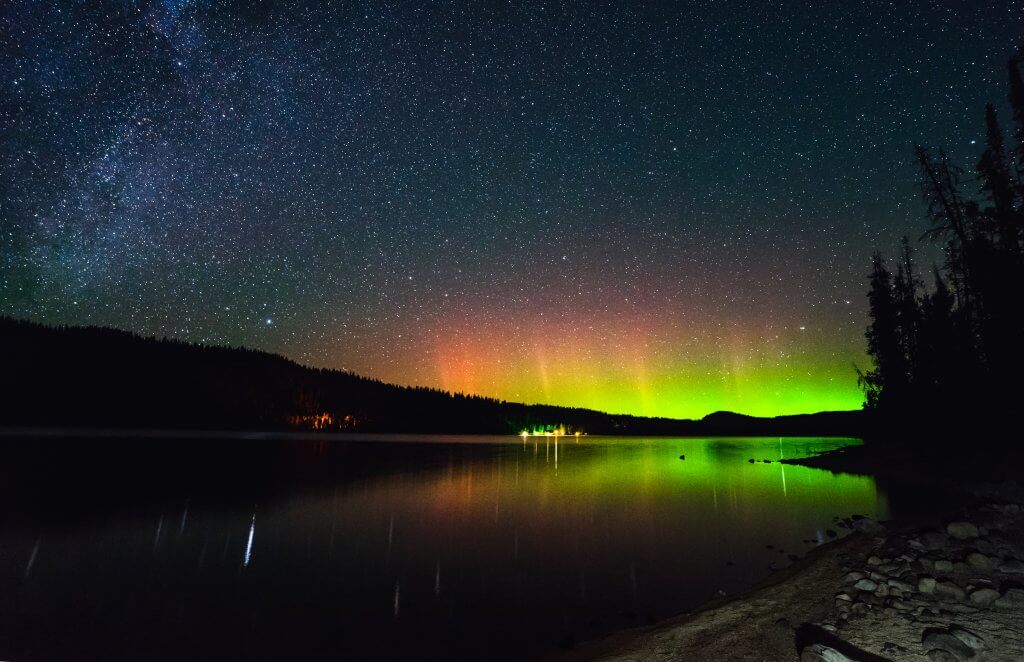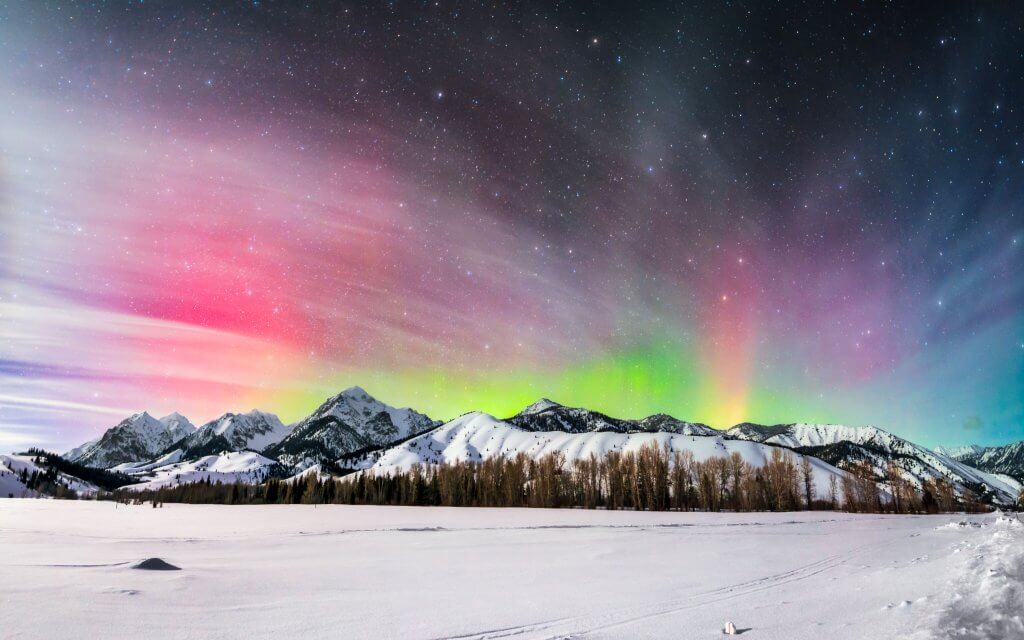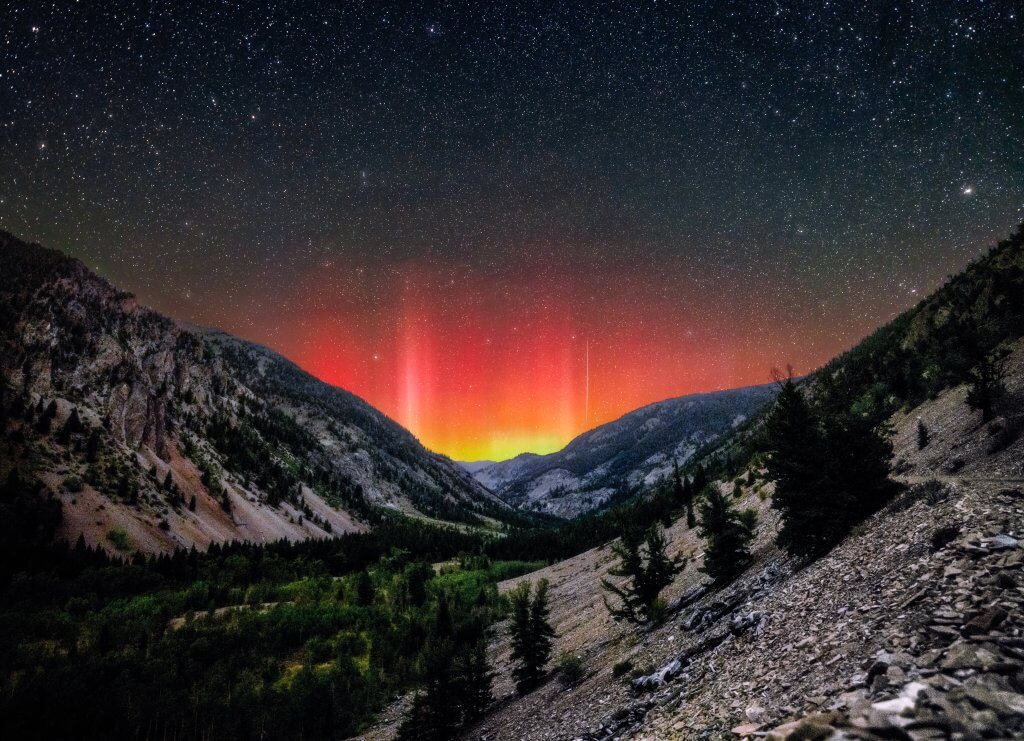Travis Amick worked in partnership with Visit Idaho to create this Travel Tip.
It is estimated that about 80 percent of North America has an obscured view of the stars and the Milky Way due to the artificial light pollution caused by cities. Luckily, Idaho is not one of those places.
The Gem State is one of the premier places on earth to stargaze and chase the northern lights due to limited light pollution, thousands of acres of untouched wilderness, two International Dark Sky Parks, and the sprawling Gold-Tier Central Idaho Dark Sky Reserve. All this is to say that with conditions like these, Idaho’s in a unique position to help you catch a glimpse of those elusive and enchanting northern lights.

An Accidental Introduction to the Northern Lights in Idaho
I first learned of the northern lights in Sun Valley by complete accident in the fall of 2016. After hours of taking photos of the Milky Way above Mount Heyburn near Stanley, I decided to set up my camera facing the North Star to capture some star trails. I set up a time-lapse with the built-in intervalometer on my Sony camera and headed to camp to sleep while my camera took over 1,000 photos throughout the night.
Waking up just before sunrise to retrieve my camera, I looked at what was captured and to my absolute surprise the northern lights were dancing across my camera screen! I was in disbelief and thus began the start of my search for the northern lights in Idaho. I spent years chasing those same conditions.

Fast forward to March 2023, I set an alarm for midnight as the clouds were set to clear for just a few hours that night, between days of winter storms. The aurora map looked good, the clouds were clearing and I just knew something good would happen. Heading north, I pulled over and took a test shot with my iPhone and the aurora was blazing. I decided this was my chance to get the Boulder Mountains shot. I dashed north and arrived just in time. As the moon lit up the Boulders the northern lights in every color imaginable erupted behind the mountains. I set up two cameras and let them do their thing as I sat and watched the flickering lights dwindle fast. They came and went throughout the night and I decided to leave after a few dazzling hours.

Returning home, out of curiosity I looked at the Banff webcam and even through the clouds, the purple made me jump out of bed and drive to Trail Creek. I arrived just in time to capture the last few massive rays of pink perfectly aligned down the road. Within minutes the rays died down and the sun slowly rose. Even when you think it’s over, they always return, always going up and down as the sun rays pulsate on the earth. If you want to see the lights prepare for a long sleepless night. But it’s worth every second when everything pans out and the lights come roaring into view.
How to Find the Northern Lights Around Sun Valley
As for viewing the aurora in Idaho, it may take a few nights under the stars, good timing, and a bit of luck. Prepare for little or no sleep, as the aurora likes to lay quiet until you are ready to give up. Then they roar up without warning shooting those brilliant colors into the sky.
The best locations will be anywhere with a clear view to the north, northeast. In Sun Valley I have had the best luck out Trail Creek as mentioned, or north of town towards Galena Summit and the Boulder Mountains. As Idaho is at a lower latitude for the northern lights, the flatter, more open locations will be best, as the lights will sit more along the horizon than directly above.

Now for the tricky part, how to actually get a night where the aurora is active. I use a variety of apps that will send alerts when there is a solar flare or possibility of aurora sighting. Aurora Pro is my favorite, from the map to live webcams and easy interface, it’s my go-to. The map gives a good indication of how far south the aurora is, mostly shown in grey for us in Idaho, and even if it says zero or even a one percent chance there is still a possibility if the map is even close to your location. The live cams are also a good way to see the aurora’s activity in other locations. I use the one in Banff, Canada as a reference point as it’s directly north of Idaho. If the aurora fills the live cam screen, you have a great chance of seeing it in Idaho.
Other good aurora apps are Aurora Forecast and Space Weather Live, though these can feel bit more complicated and scientific. There are a plethora of weather apps and night sky apps, such as PhotoPills which is amazing for any photographer. The best thing to do is just get out and see for yourself, especially in Idaho, as conditions can change minute-to-minute.
Photography Tips for Capturing the Northern Lights in Idaho
Let’s get into the more technical photography details about how I capture photos of the northern lights. First, remember charged batteries, fresh memory cards, and a good tripod as you need long exposures for night sky photos. Dress warm and bring a blanket to sit back and enjoy the show. In most of these shots my camera can see much better than my eyes in the dark. I would describe what I see as strange lights flickering above the hills, you can tell there is something going on but my camera is how I truly view them. Now let’s get to it.

Being so far south in Sun Valley most of these shots were done at 20 seconds to gather the most light while keeping the stars from trailing too much. As for aperture it really depends on your lens. Photos taken on my older 18mm were shot at f/2.8, but more recently my go-to lens is 14mm f/1.8. To gather as much light as possible you want to stay below f/2.8.
With northern lights, the ISO is always changing. A range from ISO 800-6400 will be the best bet, but depends if there is moonlight or just dark skies. You need to see this in the moment and test when you are in the field. As a starting point, set your ISO 1600-3200, and f/1.8-2.8. I also use the native camera long exposure on the newer iPhones to take a test shot. Every time I have captured the aurora the color was present first in the iPhone test shots. It is easier to take a quick test shot with the phone than to set up your large camera system. While in a location known for having northern lights you will most likely use a shorter exposure around three to ten seconds, to capture more of the moving detail in the aurora but this may not be possible in some scenarios.

Idaho is full of amazing locations and some of the best dark night skies on Earth to view the stars, meteor showers, the Milky Way, eclipses, and planets. Idaho is worth the visit for its natural beauty and dark skies alone.
Did you know there are even more places to spot the northern lights in Idaho? Get the scoop on how to find the northern lights in northern Idaho and what time of the year is best for this adventure.
Feature image credited to Travis Amick.
Travis Amick is a Sun Valley-based photographer who specializes in landscape photography, with an emphasis on night skies and long exposure photography. Follow Amick’s night sky adventures on Instagram.
Published on April 18, 2023
